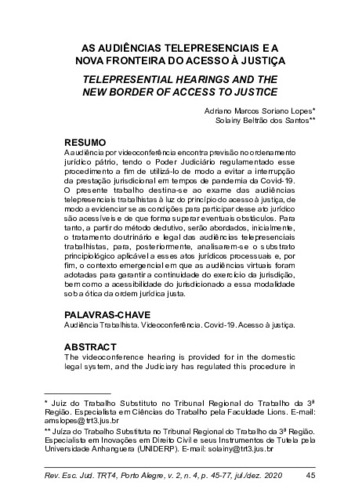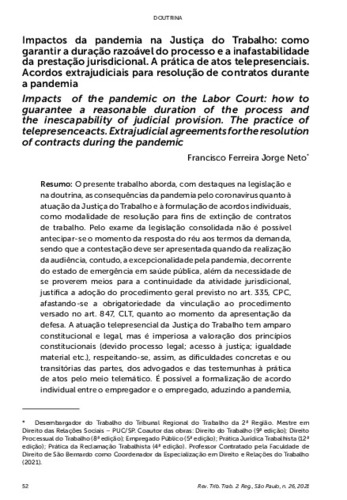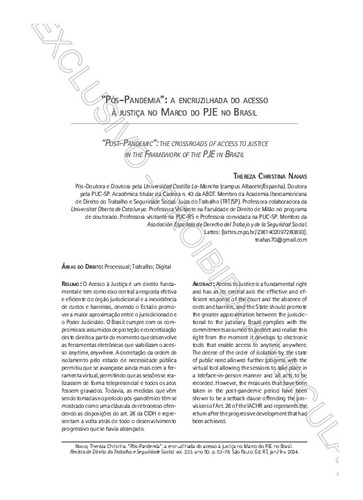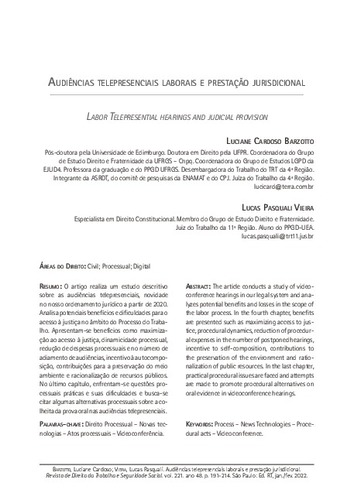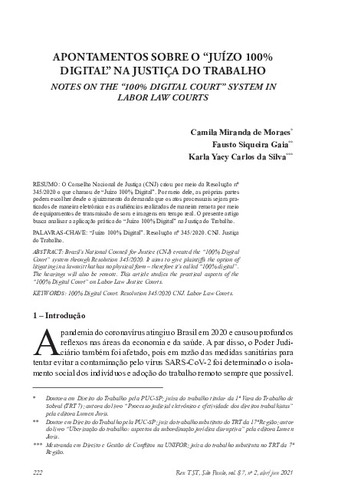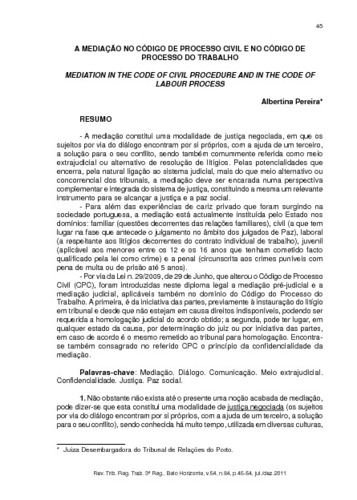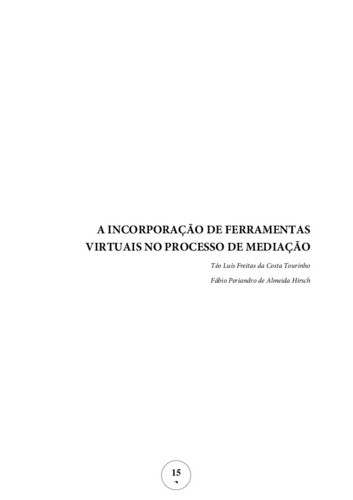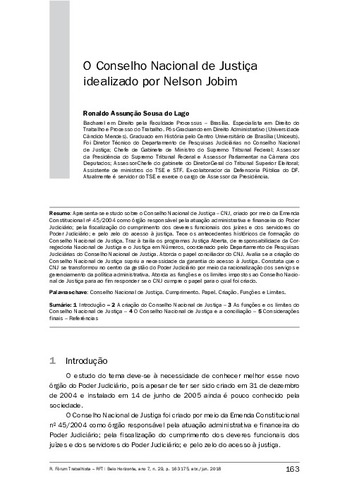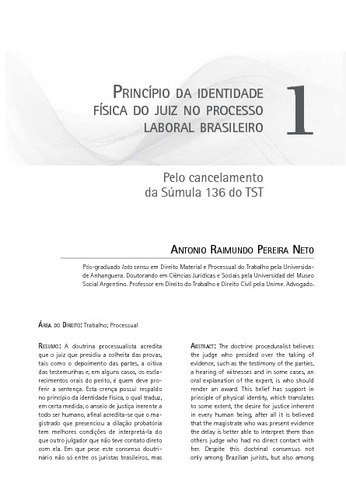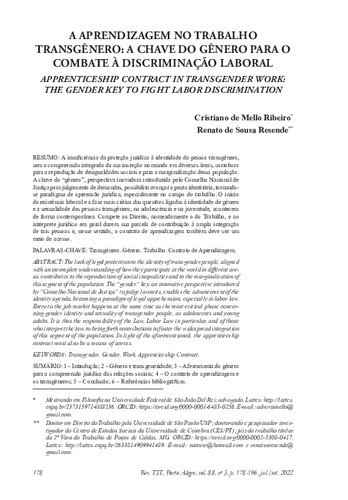Artigo de periódico
Audiências presencial e telepresencial: o acesso à justiça à luz da Resolução n. 481/2022 do CNJ
| dc.contributor.author | Richa, Morgana de Almeida | |
| dc.date.accessioned | 2023-06-29T20:23:20Z | |
| dc.date.available | 2023-06-29T20:23:20Z | |
| dc.date.issued | 2023-03 | |
| dc.identifier.citation | RICHA, Morgana de Almeida. Audiências presencial e telepresencial: o acesso à justiça à luz da Resolução n. 481/2022 do CNJ = In-person and virtual hearings: access to justice under the light of CNJ Resolution n. 481/2022. Revista do Tribunal Superior do Trabalho, São Paulo, v. 89, n. 1, p. 234-250, jan./mar. 2023. | pt_BR |
| dc.identifier.uri | https://hdl.handle.net/20.500.12178/217895 | |
| dc.description | Informação sobre a autora: Ministra, Tribunal Superior do Trabalho. | pt_BR |
| dc.description.abstract | [por] Trata da coexistência dos modelos de audiência presencial e telepresencial, decorrente da evolução do acesso à justiça e da chamada Justiça 4.0, no período pós-pandêmico. De um lado, tem-se a audiência presencial, ritualística, litúrgica, em que os participantes têm identidade clara, com imediatidade física do juiz na coleta de provas orais. De outro, a mudança de paradigma, com a migração da audiência para o meio telemático ou virtual, em que todos são aparentemente iguais, com identidade difusa, no qual o juiz está na "nuvem", em situação de ubiquidade, e o Judiciário é um serviço e não um lugar. Com vistas ao exame da conjuntura que deu origem ao fenômeno e suas implicações jurídicas, busca-se a aferição das vantagens e desvantagens de cada arquétipo. Todo o estudo tem lugar à luz da Resolução n. 481/2022 do Conselho Nacional de Justiça e do paradigma que traz a debate, na esteira da efetiva democratização do acesso à prestação jurisdicional. | pt_BR |
| dc.description.abstract | [eng] This paper aims to address the coexistence of in-person and virtual hearing models, resulting from the evolution of access to justice and the so-called Justice 4.0, in the post-pandemic period. On the one hand, there is the in-person, ritualistic, liturgical hearing, in which the participants have a clear identity, with the physical immediacy of the judge in the collection of oral evidence. On the other hand, the paradigm shift with the migration of the audience to the telematic or virtual environment, in which everyone is apparently equal, with a diffuse identity, in which the judge is in the "cloud", in a situation of ubiquity, and the Judiciary is a service and not a place. In order to examine the conjuncture that gave rise to the phenomenon and its legal implications, the study seeks to assess the advantages and disadvantages of each model. The entire study will take place under the light of Resolution no. 481/2022 of the National Council of Justice and the paradigm that it brings to debate, with a view to the effective democratization of access to justice. | pt_BR |
| dc.description.tableofcontents | O acesso à justiça na era digital: juízos físico, híbrido e 100% virtual -- Audiências na Justiça do trabalho -- Resolução n. 481, de 22 de novembro de 2022, do Conselho Nacional de Justiça: definição das balizas | pt_BR |
| dc.language.iso | pt_BR | pt_BR |
| dc.relation | Resolução n. 481/CNJ, de 22 de novembro de 2022 | pt_BR |
| dc.relation.ispartof | Revista do Tribunal Superior do Trabalho: vol. 89, n. 1 (jan./mar. 2023) | pt_BR |
| dc.relation.uri | https://atos.cnj.jus.br/atos/detalhar/4842 | pt_BR |
| dc.subject | Audiência (processo trabalhista), Brasil | pt_BR |
| dc.subject | Acesso à justiça, inovação tecnológica, Brasil | pt_BR |
| dc.subject | Processo eletrônico, Brasil | pt_BR |
| dc.subject | Videoconferência, Brasil | pt_BR |
| dc.title | Audiências presencial e telepresencial: o acesso à justiça à luz da Resolução n. 481/2022 do CNJ | pt_BR |
| dc.title.alternative | In-person and virtual hearings: access to justice under the light of CNJ Resolution n. 481/2022 | pt_BR |
| dc.type.genre | Artigo de periódico | pt_BR |
| dc.identifier.rvbisys | 1241989 | |
| dc.relation.ispartoflink | https://hdl.handle.net/20.500.12178/216997 | pt_BR |



